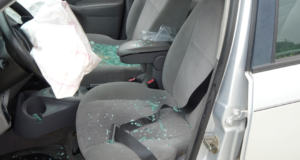The focus of this Instructor Newsletter is to reinforce the need for vehicle rescue team members to understand why roof removal tasks require the crew to “strip the trim”. This simple action can make a big difference in safety at the crash scene.
Our scenario today involves the Cadillac Escalade vehicle shown above. Let us assume that it has been in a serious collision and multiple occupants are trapped. The rescue officer has decided that the team should accomplish total roof removal. Because this is a pickup-type vehicle, when ready for the roof to be cut off, there may be a tendency for the crew to just simply start cutting pillars. Who would ever think there’d be roof airbags and stored gas inflators on a pickup truck!
With the interior roof pillars (and even portions of the headliner) removed, it becomes clear that this Denali truck does in fact have roof-mounted airbags. Many brands of pickup trucks have this occupant safety feature now. The teaching point that vehicle rescue instructors must reinforce is that rescue teams should adopt the discipline that “stripping the trim” is a mandatory task before cutting any roof pillar on any make, model, or style of vehicle. Once the trim is removed, rescuers are able to work around the stored gas inflators as they cut through the pillar.
As a vehicle rescue officer and especially one who trains others, after talking about stripping the trim, you have a second teaching point to address. The question will come up, “I stripped the trim and can see the inflator, but now where do I cut?” As you can see in this last image, this driver’s side C-pillar could possibly be cut through below the stored gas inflator. Explain that the pillar cut on this Denali could also be made by cutting through the pillar near the roofline which would also cut through the discharge tubing of the stored gas inflator. Stored pressure is only in the cylinder-shaped inflator, not the tubing.
 University of Extrication Ron Moore's University of Extrication is the online home for training tips, news and information pertaining to vehicle extrication and rescue.
University of Extrication Ron Moore's University of Extrication is the online home for training tips, news and information pertaining to vehicle extrication and rescue.





